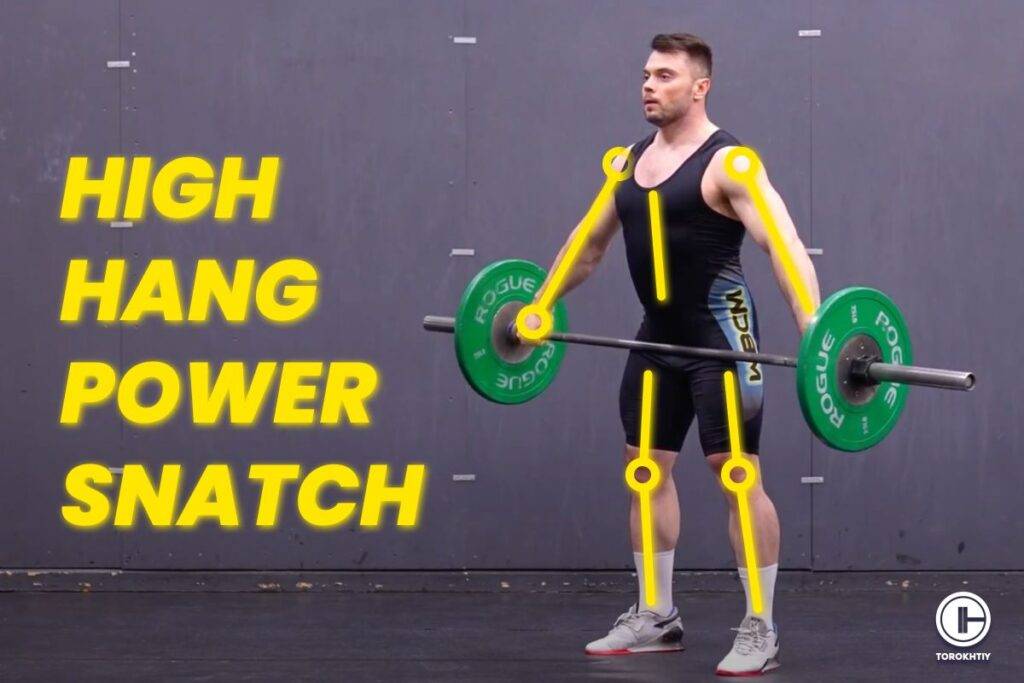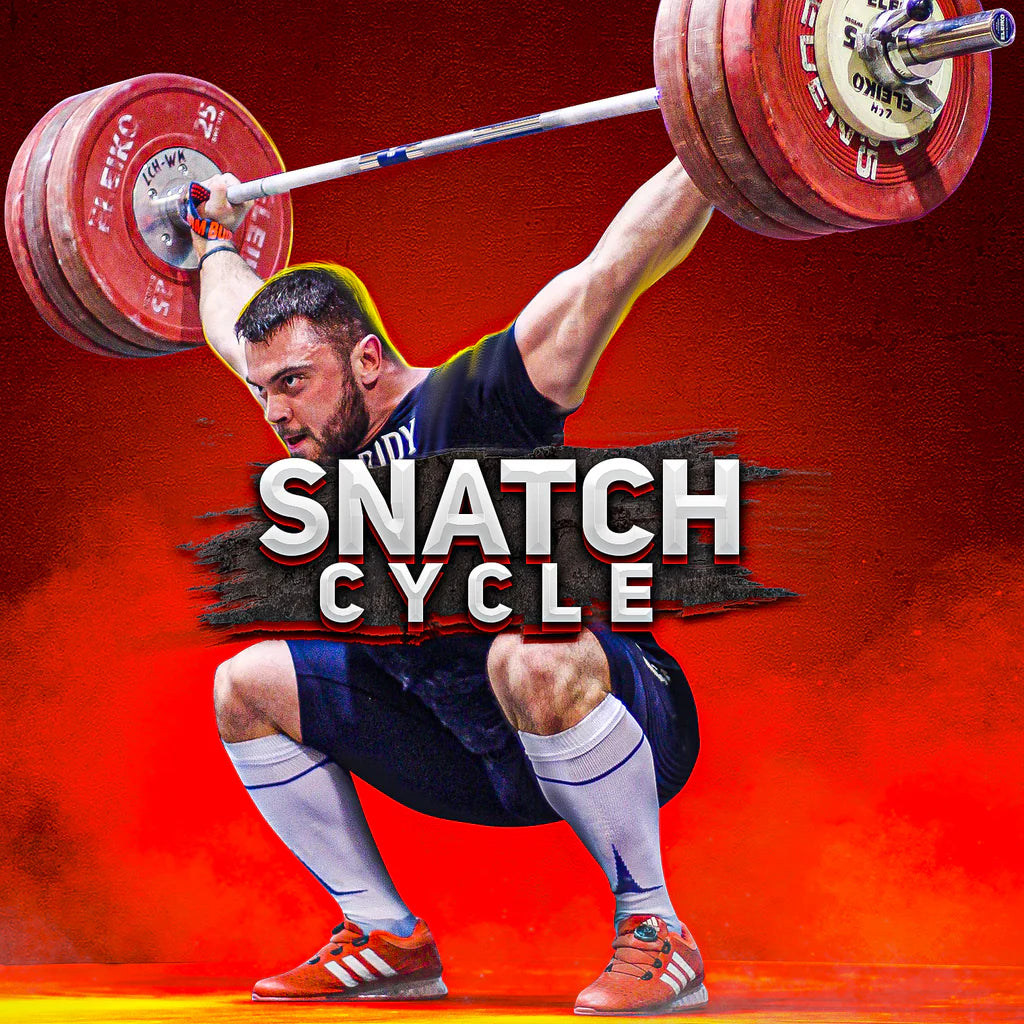High Hang Power Snatch: Technique, Benefits and Common Mistakes
If you haven’t heard of the high hang power snatch, you’ve never tried it, don’t know anything about it – you’re missing out. It’s dynamic, has a bunch of benefits, and if your routine is feeling a bit boring, this is the perfect way to freshen it up.
You can use a barbell or a dumbbell for it (although we’ll be focusing on the barbell, of course), and it will fit into any type of routine. Whether you’re into weightlifting, Functional Fitness or you just want to challenge yourself, this is an exercise you absolutely need to try.

What Is the High Hang Power Snatch?
This mouthful of an exercise is a dynamic movement that combines strength, speed, and precision. It starts with a barbell (or a dumbbell) at your hips or upper thighs and your goal is to explosively lift it over your head in one fluid motion.
You’ll need coordination and balance to be able to do it because you’ll need to quickly go from the high hang to catching the weight overhead in either a deep squat or a partial squat.
How to Do the High Hang Power Snatch?
Now let’s go on to the main thing – how to do it!
1. Setup + Starting Position
Your feet should be shoulder-width apart with your toes pointing out a little. Use a wide grip on the barbell and hold it in your hip crease – this is where everything starts.
To get yourself into the starting position of the high hang variant you need to hinge at the hips, bend your knees slightly and lower the bar to mid thigh or just above the knees. Shoulders are over the bar, back flat, elbows out and arms relaxed – this is your starting position.

2. 2nd pull + Power Position
Extend your hips and knees at the same time while keeping the barbell close to your body. Move the bar up in a fast and controlled way.
As the bar goes up, aggressively extend your hips and knees. This will help you generate the power you need. Extend your body completely and pull the bar up. Your shoulders should be shrugged up and back and your elbows should keep driving the bar up.

3. Turnover and Catch
As you pull under the bar, rotate your wrists and elbows to get under it. Catch the bar in a partial squat and keep the core engaged to stabilize the bar overhead.

4. Recovery
Extend your hips and knees, stand up, and make sure the bar is stable overhead. Lower it back to where you started from in a controlled manner.
A Simple High Hang Power Snatch Program
1. Beginners
- Reps: 3-5 reps per set
- Sets: 3 sets
- Frequency: 1-2 times per week
- Progression: Form comes first, so refrain from lifting heavy weights and master the form – it’s what keeps you safe and makes the lift effective.
2. Intermediate
- Reps: 3-5 reps per set
- Sets: 4-5 sets
- Frequency: 2-3 times per week
- Progression: You can add more weight to challenge your strength and power.
3. Advanced
- Reps: 1-5 reps per set
- Sets: 3-5 sets
- Frequency: 1-3 times per week
- Progression: Since you’re already advanced, you need to focus on your limiting factors, whether that is strength, power, some specific movement element, technique, etc. Adjust the weight based on force-velocity curve.
🔻5-week Snatch Training Program!

🏋️♂️Achieve:
🔹Achieve new Snatch Records.
🔹Master Snatch variations.
🔹Enhance technique and strength.
🔹Targeted drills for Snatch perfection.
⚡Highlights:
🔹5 Days / Week
🔹Varied Snatch Lifts
🔹Focus on Strength & Technique
🔹Smart Warm-Ups.
Dominate your Snatch game NOW! 💥
3 Common High Hang Power Snatch Mistakes
Mistakes are a learning experience, but you should still be aware of what the most common ones are so you can avoid them.
1. Starting Too Low or not bending at all
If you’re a beginner, there’s a good chance you’ll start too low, and this will mess up the mechanics of the lift. The high hang position is just above the knees or at the middle of your thighs. Another thing is that there is similar exercise – Tall Snatch – that doesn’t require that initial bar drop but as we said it’s a different exercise that focuses on something else.

2. Incomplete Extension
Make sure to fully extend your hips and knees during the upward phase of the snatch. Otherwise, you’ll limit the power the lift generates.
3. Early Arm Bend
If you bend your arms too early, you’ll put a damper on the efficiency and the power of the movement. The arms need to stay straight until the bar reaches max height.

3 Benefits of High Hang Power Snatch
Apart from the satisfaction of being able to master this cool movement, there are other benefits that come with it:
1. Better Athletic Performance
This is an exercise that will improve your power, specific strengths, and coordination, which will directly translate into better athletic performance.
2. Increased Bone Density
The high hang power snatch is a weight-bearing exercise, and those will improve your bone density, which is especially important for preventing osteoporosis.
3. Better Joint Stability & Mobility
You’ll need to keep the stability in your shoulders, hips, and ankles so, if you do the high hang power snatch on a regular basis, you can expect better joint stability and mobility.
3 High Hang Power Snatch Alternatives
If you want the benefits of the high hang power snatch, but you want an exercise that differs from it more than a variation, we have just the thing! Well… A couple of them.
1. High Hang Snatch
After you do the high hang power snatch, drop into a deep squat rather than a partial one and see how it goes.
2. High Hang Power Clean
This one starts with the barbell at the high hang position (just above the knees) and then from here, you explosively extend your hips and knees while pulling the barbell up. As it peaks, quickly drop into a partial squat and catch the bar on your shoulders. Stand up to complete the lift.
3. Kettlebell Snatch
Start with a kettlebell between your feet and use a shoulder-width stance. Hinge at the hips and swing the kettlebell back between your legs. Explosively drive your hips forward to propel the kettlebell up. As it rises, rotate your hand and wrist to guide the kettlebell overhead.
Who Should Do the High Hang Power Snatch?
1. Athletes
Soccer, basketball, and football players will have lots of benefits from the high hang power snatch, as well as weightlifters and pretty much anyone else that wants to work on their explosive power, strength, and coordination.
2. Fitness Enthusiasts
Since this is a full-body exercise that will target multiple muscle groups at the same time, everyone that wants to improve their functional fitness and athleticism should do the high hang power snatch.
3. People Who Want to Develop Power and explosive strength
Better power output is one of the benefits of the high hang power snatch because it requires a quick hip extension and shoulder shrug to propel the weight up.
Muscles Worked by the High Hang Power Snatch
As we’ve mentioned already, this is an exercise that will engage your entire body.
During the second pull, as you extend your hips and knees, the glutes, hamstrings, and lower back are engaged to generate power. As you catch the weight, the core stabilizes your body, and your arms control the weight.
During the final phase, your traps, shoulders, and upper back are engaged. Apart from strengthening your muscles, the high hang power snatch improves your coordination and balance.
Conclusion
So what do we mean by all of this and what’s the point you want to remember? In short – the high hang power snatch is an exercise you absolutely need in your routine. It will engage your entire body, has a lot of health benefits, and if you’re used to the classics, it’s a fun way to switch things up.
Have you tried it already? If you have, what benefits have you seen from it? What are the biggest challenges you had to push through?
We’d love to see anything you have to share, and if there’s anything we missed – feel free to add it!
References:
- Health Promotion Board (HPB) “Prevent Injuries with Proper Form During Workouts,” Singapore University Health Center, https://www.nus.edu.sg/uhc/articles/details/prevent-injuries-with-proper-form-during-workouts (accessed June 18th, 2024)
- Mayo Clinic Staff, “Weight training: Do’s and don’ts of proper technique,” Mayo Clinic, https://www.mayoclinic.org/healthy-lifestyle/fitness/in-depth/weight-training/art-20045842 (accessed June 18th, 2024)
- “Prevention Osteoporosis,” National Health Service, https://www.nhs.uk/conditions/osteoporosis/prevention/ (accessed June 18th,2024)
- “Slowing bone loss with weight-bearing exercise,” Harvard Health Publishing, https://www.health.harvard.edu/staying-healthy/slowing-bone-loss-with-weight-bearing-exercise (accessed June 18th, 2024)
- Photos by Torokhtiy Media Team.
Why Trust Us?
With over 20 years in Olympic Weightlifting, our team does its best to provide the audience with ultimate support and meet the needs and requirements of advanced athletes and professional lifters, as well as people who strive to open new opportunities and develop their physical capabilities with us.
All products we select are primarily approved and tested by the Olympic Weightlifting Champion Oleksii Torokhtiy. Under his guidance, we provide honest and reasonable assessments of the products we review by checking their characteristics, packaging, design, comfort and durability features, and general product rating. We select products from only high-quality and trusted sports brands, thus vouching for their quality.
The product testing process is described in more detail here

